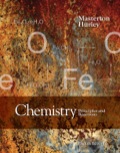
Concept explainers
(a)
Interpretation:
To state the balanced chemical equation for the given reaction and give the name of the products so formed.
Concept introduction:
A balanced
(b)
Interpretation:
To state the balanced chemical equation for the given reaction and give the name of the products so formed.
Concept introduction:
A balanced chemical reaction equation is the one in which the number of atoms of all the elements are equal on both the sides of the chemical equation.A compound refers to a substance which contains definite proportion of two or more elements joined together through chemical bonds. A chemical formula depicts the number of atoms of each element present in a compound. It consists of symbols of each of the atoms present in the given compound as well as how many atoms of each element are present in the compound are denoted by a subscript.
(c)
Interpretation:
To state the balanced chemical equation for the given reaction and give the name of the products so formed.
Concept introduction:
A balanced chemical reaction equation is the one in which the number of atoms of all the elements are equal on both the sides of the chemical equation.A compound refers to a substance which contains definite proportion of two or more elements joined together through chemical bonds. A chemical formula depicts the number of atoms of each element present in a compound. It consists of symbols of each of the atoms present in the given compound as well as how many atoms of each element are present in the compound are denoted by a subscript.
(d)
Interpretation:
To state the balanced chemical equation for the given reaction and give the name of the products so formed.
Concept introduction:
A balanced chemical reaction equation is the one in which the number of atoms of all the elements are equal on both the sides of the chemical equation.A compound refers to a substance which contains definite proportion of two or more elements joined together through chemical bonds. A chemical formula depicts the number of atoms of each element present in a compound. It consists of symbols of each of the atoms present in the given compound as well as how many atoms of each element are present in the compound are denoted by a subscript.
Want to see the full answer?
Check out a sample textbook solution
Chapter 20 Solutions
EBK CHEMISTRY: PRINCIPLES AND REACTIONS
- Don't use ai to answer I will report you answerarrow_forwardConsider a solution of 0.00304 moles of 4-nitrobenzoic acid (pKa = 3.442) dissolved in 25 mL water and titrated with 0.0991 M NaOH. Calculate the pH at the equivalence pointarrow_forwardWhat is the name of the following compound? SiMe3arrow_forward
- K Draw the starting structure that would lead to the major product shown under the provided conditions. Drawing 1. NaNH2 2. PhCH2Br 4 57°F Sunny Q Searcharrow_forward7 Draw the starting alkyl bromide that would produce this alkyne under these conditions. F Drawing 1. NaNH2, A 2. H3O+ £ 4 Temps to rise Tomorrow Q Search H2arrow_forward7 Comment on the general features of the predicted (extremely simplified) ¹H- NMR spectrum of lycopene that is provided below. 00 6 57 PPM 3 2 1 0arrow_forward
 Chemistry: Principles and ReactionsChemistryISBN:9781305079373Author:William L. Masterton, Cecile N. HurleyPublisher:Cengage Learning
Chemistry: Principles and ReactionsChemistryISBN:9781305079373Author:William L. Masterton, Cecile N. HurleyPublisher:Cengage Learning Chemistry & Chemical ReactivityChemistryISBN:9781337399074Author:John C. Kotz, Paul M. Treichel, John Townsend, David TreichelPublisher:Cengage Learning
Chemistry & Chemical ReactivityChemistryISBN:9781337399074Author:John C. Kotz, Paul M. Treichel, John Townsend, David TreichelPublisher:Cengage Learning Chemistry & Chemical ReactivityChemistryISBN:9781133949640Author:John C. Kotz, Paul M. Treichel, John Townsend, David TreichelPublisher:Cengage Learning
Chemistry & Chemical ReactivityChemistryISBN:9781133949640Author:John C. Kotz, Paul M. Treichel, John Townsend, David TreichelPublisher:Cengage Learning Chemistry by OpenStax (2015-05-04)ChemistryISBN:9781938168390Author:Klaus Theopold, Richard H Langley, Paul Flowers, William R. Robinson, Mark BlaserPublisher:OpenStax
Chemistry by OpenStax (2015-05-04)ChemistryISBN:9781938168390Author:Klaus Theopold, Richard H Langley, Paul Flowers, William R. Robinson, Mark BlaserPublisher:OpenStax Chemistry: Principles and PracticeChemistryISBN:9780534420123Author:Daniel L. Reger, Scott R. Goode, David W. Ball, Edward MercerPublisher:Cengage Learning
Chemistry: Principles and PracticeChemistryISBN:9780534420123Author:Daniel L. Reger, Scott R. Goode, David W. Ball, Edward MercerPublisher:Cengage Learning




